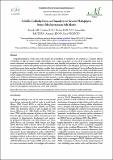Por favor, use este identificador para citar o enlazar a este item:
http://hdl.handle.net/10261/48597COMPARTIR / EXPORTAR:
 SHARE
BASE SHARE
BASE
|
|
| Visualizar otros formatos: MARC | Dublin Core | RDF | ORE | MODS | METS | DIDL | DATACITE | |

| Título: | Soluble Carbohydrates as Osmolytes in Several Halophytes from a Mediterranean Salt Marsh |
Autor: | Gil, Ricardo; Lull, Cristina; Boscaiu, Mónica; Bautista, Inmaculada; Lidón, Antonio; Vicente, Óscar CSIC ORCID | Palabras clave: | Salinity tolerance Plantago-crassifolia Stress Proline |
Fecha de publicación: | jul-2011 | Citación: | Notulae Botanicae Horti Agrobotanici Cluj-Napoca 39/2:9-17 (2011) | Resumen: | Compartmentalization of toxic ions in the vacuole and accumulation of osmolytes in the cytoplasm is a common response of halophytes to high soil salinity. Soluble carbohydrates, such as sugars and polyols, are some of the compatible solutes used for osmotic adjustment and osmoprotection. Major carbohydrates were identified and quantified by high-performance anion-exchange chromatography, combined with pulsed amperometric detection (HPAEC-PAD), in five halophytic species from a Mediterranean salt marsh (Juncus acutus, Juncus maritimus, Plantago crassifolia, Inula crithmoides and Sarcocornia fruticosa). Sucrose, followed by glucose and fructose were the more representative sugars detected in J. acutus and J. maritimus, and sorbitol the only soluble carbohydrate present at significant levels in P. crassifolia. In the other two taxa analyzed, no clearly predominant carbohydrates were observed: polyols (myo-inositol and glycerol) seemed to be the most representative in I. crithmoides, albeit at relatively low concentrations, and sugars (sucrose and glucose) in S. fruticosa. Multivariate statistical analysis was used to correlate soil properties and meteorological conditions increasing soil salinity, with seasonal changes in carbohydrate contents, to establish their possible function as osmolytes and their contribution to salt tolerance in the investigated species. The obtained results confirmed sorbitol as the major functional osmolyte in P. crassifolia-as it has been described previously for other species of the genus-and suggested the participation of sucrose and, to a lesser extent, glucose and fructose in osmoregulatory mechanisms in J. acutus and J. maritimus. | URI: | http://hdl.handle.net/10261/48597 | E-ISSN: | 1842-4309 |
| Aparece en las colecciones: | (IBMCP) Artículos |
Ficheros en este ítem:
| Fichero | Descripción | Tamaño | Formato | |
|---|---|---|---|---|
| NotullaeB_39_9(2011).pdf | 362,13 kB | Adobe PDF |  Visualizar/Abrir |
CORE Recommender
Page view(s)
323
checked on 24-abr-2024
Download(s)
266
checked on 24-abr-2024
Google ScholarTM
Check
NOTA: Los ítems de Digital.CSIC están protegidos por copyright, con todos los derechos reservados, a menos que se indique lo contrario.
